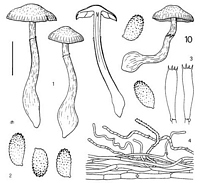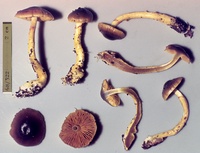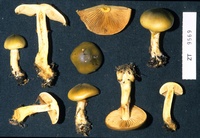|
 Dermocybe olivaceonigra Dermocybe olivaceonigra
SynonymsCortinarius olivaceoniger
BiostatusPresent in region - Indigenous. Endemic
Images (click to enlarge)
Caption: Dermocybe olivaceonigra: 1. carpophores. - 2. spores. - 3. basidia. - 4. pileipellis. | 
Caption: ZT68-322 , Holotype
Owner: E. Horak: © Creative Commons Attribution-Noncommercial 3.0 New Zealand | 
Caption: ZT9569
Owner: E. Horak: © Creative Commons Attribution-Noncommercial 3.0 New Zealand |
Article: Horak, E. (1988) [1987]. New species of Dermocybe (Agaricales) from New Zealand. Sydowia 40: 81-112.
Description: Pileus - 40 mm, convex to broadly umbonate or obtusely campanulate; fuliginous or olive-brown at centre, towards margin turning olive-yellow or bright yellow; subgelatinous to viscid, striate margin when moist, hygrophanous, conspicuous veil remnants absent. - Lamellae l0-26, -7, emarginate, subdecurrent with tooth, -6 mm wide; dark yellow (with greenish tinge) turning yellow-rust brown; edges concolorous, entire. - Stipe-70 x -4 (-13 at base) mm, slender, fusoid to subbulbous towards base, rarely cylindrical, single; yellow to olive-yellow, occasionally with yellow rhizoids; glutinous from base to evanescent cortina, longitudinally fibrillose in dry conditions, solid becoming hollow. - Context olive-brown in pileus and stipe, yellow beneath stipe's cuticle. - Odour and taste raphanoid (or like raw potatoes). - Chemical reactions on pileus and stipe: KOH - red to red-brown; HCl, NH3 negative.
Spore print rust brown. - Spores 7.5-9 x 4.5-5 µm, elliptical, minutely verrucose, with coarse warts at apex, rarely with distinct perispore, rust-brown. -Basidia 25-35 x 6-8 µm, 4-spored. - Cheilocystidia none. - Pileipellis an ixocutis composed of cylindrical, gelatinized, entangled hyphae (2-6 µm diam.), subcutis cellular, with red-brown encrusting and plasmatic pigment, readily dissolving in KOH (solvent stains red-purple). - Clamp connections present.
Habitat: On soil in Nothofagus-forests. - New Zealand.
Notes: D. olivaceonigra closely resembles the more common D. alienata by similar habit, the presence of olive-green pigments (in both taxa KOH-spot test red!), the glutinous to viscid pileus and the occurrence in Nothofagus-forests. The two species, however, are distinguished by the size of the spores (larger in D. olivaceonigra) and the number and variety of anthraquinonoid pigments (KELLER & al., 1988). In D. olivaceonigra the olive-yellow colour of the carpophores is partly caused by endocrocin which lacks in the pigment chart of D. alienata.
|